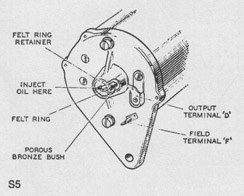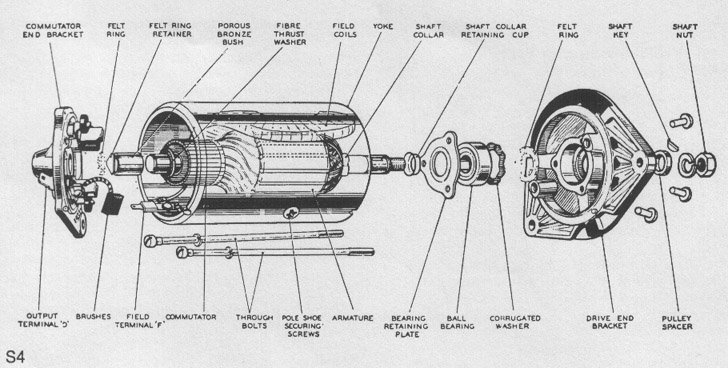

With a Large Dynamo Diagram at bottom of page.
Dynamo
Models C40A and C40L
General
The following information concerns the two types of
dynamo fitted as standard equipment to the 4.236
engine namely, the Lucas C40A and C40L models. If
information concerning another type of dynamo is re-
quired. the relevant manufacturer should be contacted.
The C40A is a non-ventilated unit. It will be found
fitted to applications such as agricultural machines,
which operate under exposed service conditions. The
C40L s a ventilated dynamo and will be found on
applications such as road vehicles, which operate
under cleaner conditions.
Both Types are shunt-wound two-pole two-brush mach-
ines to work in conjunction with a compen-
sated control regulator unit. A ball bearing
supports armature at the driving end and a porous
bronze bush at the rear supports the commutator end.
The output of the dynamo is controlled by the regulator
unit and is dependant on the state of charge of the
battery and the loading of the electrical equipment in use.
When the battery is in a low state of charge, the
dynamo gives a hige output, whereas if the battery is fully charged,
the dynamo gives only sufficient output to keep the battery in good
condition without any possibility of overcharging.
An increase in output is given to balance the current taken by lamps
and other accessories when in use.
When fitting a new control box, it is important to use
only an authorised replacement. An incorrect replace-
ment can result in damage to the dynamo.
Routine Maintenance
(a) Lubrication
Every 5,000 miles (7,500 km) or 250 running hours, inject
a fewdrops of high quality S.A.E. 30 engine oil in to the hole
marked "Oil" at the commutator end bearing housing (see
Fig.S.5).
(b) Inspection of Brushgear
Every 60,000 miles (90,000 km) or 2,500 running hours,
the dynamo should be removed from the engine and the
brushgear inspected by an auto-electrician.
(c) Belt Adjustment
Occasionally inspect the dynamo driving belt, and if
necessary adjust to take up any slackness by turning
the dynamo on its mounting. Care should be taken to
avoid overtightening the belt.

© Dodge50.co.uk™ 2002